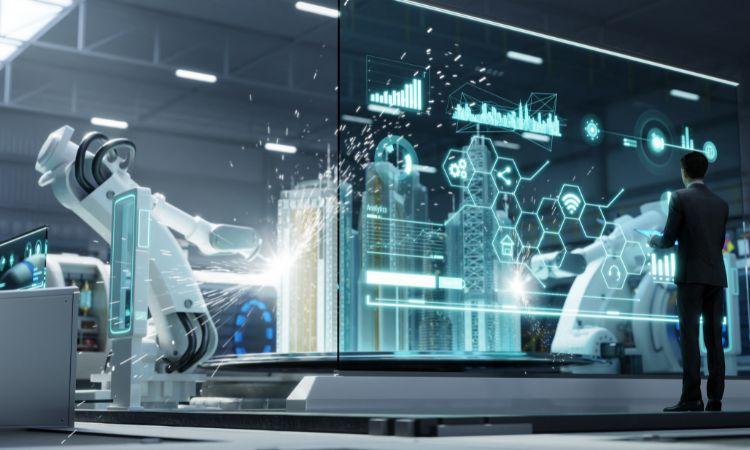The global industrial control and factory automation market size reached a value of about USD 130 billion in 2021. The industry is further expected to grow at a CAGR of 7.90% in the forecast period of 2024-2032 to reach a value of around USD 204.6 billion by 2027. These staggering numbers are a testament to the rapid evolution of the manufacturing sector, where innovation plays a pivotal role. Among the technological advancements transforming the landscape, one stands out prominently—Artificial Intelligence (AI). In this blog post, we will delve deep into “The Role of Artificial Intelligence in Industrial Control Systems,” exploring its origins, applications, challenges, and the profound impact it is making on the manufacturing world.
I. Understanding Industrial Control Systems (ICS)
Before we explore the impact of AI, let’s first establish a foundational understanding of Industrial Control Systems (ICS). Industrial Control Systems encompass a wide array of technologies and processes designed to monitor and control industrial operations. Historically, these systems were primarily rule-based and relied on manual intervention. They were essential but lacked the dynamism required in today’s fast-paced manufacturing environments.
Industrial Control Systems have traditionally been divided into three categories:
-
Supervisory Control and Data Acquisition (SCADA) Systems: These systems gather and analyze data from various sensors and devices in real-time, allowing operators to monitor and control industrial processes.
-
Programmable Logic Controllers (PLCs): PLCs are specialized computers that control machinery and industrial processes. They are highly reliable and are programmed to perform specific tasks.
-
Distributed Control Systems (DCS): DCSs are used to control complex processes, such as those in chemical plants and power generation facilities. They consist of multiple control units distributed throughout a plant.
In essence, ICS has been the backbone of modern manufacturing, enabling efficient and precise control over various industrial processes.
II. The Rise of Artificial Intelligence
The rise of Artificial Intelligence has been a game-changer in multiple industries, and manufacturing is no exception. AI, a branch of computer science that deals with creating intelligent machines capable of mimicking human cognition, is transforming the way industrial processes are controlled and optimized. Its application in industrial control systems is a response to the need for greater efficiency, productivity, and adaptability.
The journey of AI in manufacturing began with the development of expert systems in the 1960s and 1970s. These early AI systems were rule-based and could make decisions based on predefined rules and knowledge. However, their capabilities were limited, and they lacked the ability to learn from data.
The breakthrough came with the advent of Machine Learning (ML) in the late 20th century. ML algorithms enabled computers to learn from data and improve their performance over time. This capability opened up new possibilities for AI in manufacturing, as it allowed systems to adapt to changing conditions and make predictions based on historical data.
Today, the integration of AI into industrial control systems represents a quantum leap in manufacturing technology. AI systems can process vast amounts of data, identify patterns, make predictions, and optimize processes in real-time. This level of intelligence and adaptability is revolutionizing manufacturing operations across various industries.
III. Applications of AI in Industrial Control Systems
A. Predictive Maintenance
One of the most significant applications of AI in Industrial Control Systems is predictive maintenance. Traditional maintenance practices often involve scheduled inspections and replacements, leading to inefficiencies and costly downtime. AI-driven predictive maintenance systems, on the other hand, analyze data from sensors, historical maintenance records, and other sources to predict when equipment is likely to fail. By addressing issues before they become critical, manufacturers can minimize downtime, reduce maintenance costs, and extend the lifespan of machinery.
The process of implementing predictive maintenance with AI typically involves the following steps:
-
Data Collection: Sensors and IoT devices collect data on equipment performance, temperature, vibration, and other relevant metrics.
-
Data Analysis: AI algorithms analyze the collected data to detect patterns and anomalies.
-
Predictive Models: AI systems build predictive models that estimate the remaining useful life of equipment and identify potential failure points.
-
Maintenance Alerts: When the AI system detects an impending issue, it generates maintenance alerts, prompting maintenance teams to take proactive action.
-
Optimization: Over time, the AI system improves its predictions by continuously learning from new data.
Predictive maintenance not only reduces unplanned downtime but also lowers maintenance costs and improves overall equipment effectiveness. It allows manufacturers to shift from reactive maintenance practices to a proactive and data-driven approach.
B. Quality Control and Inspection
AI-powered vision systems have revolutionized quality control and inspection processes in manufacturing. These systems use computer vision and machine learning algorithms to identify defects and anomalies in real-time. They can analyze vast amounts of visual data much faster and with higher accuracy than human operators.
The key components of AI-powered quality control systems include:
-
High-Resolution Cameras: Industrial cameras capture detailed images of products or components.
-
Computer Vision Algorithms: AI algorithms process the images and identify defects, irregularities, or variations in products.
-
Machine Learning Models: Machine learning models are trained on large datasets to recognize specific quality criteria and defects.
-
Real-Time Feedback: AI systems provide real-time feedback to operators, flagging any products that do not meet quality standards.
-
Data Logging: Data on product quality is logged for traceability and quality assurance.
AI-driven quality control systems have a wide range of applications, from inspecting the surface finish of manufactured goods to identifying defects in automotive parts and electronics assembly. They can detect subtle defects that may be difficult for human inspectors to spot, ensuring that only high-quality products reach consumers.
C. Process Optimization
AI excels in optimizing manufacturing processes. It can analyze complex data streams from sensors, control systems, and IoT devices to make real-time adjustments that ensure optimal output quality and energy efficiency. This capability is particularly valuable in industries where small adjustments can have a significant impact on production efficiency and cost savings.
The process optimization capabilities of AI include:
-
Real-Time Monitoring: AI systems continuously monitor process variables, such as temperature, pressure, flow rates, and production rates.
-
Data Analysis: AI algorithms analyze the data to identify deviations from ideal conditions and performance benchmarks.
-
Predictive Analytics: AI can predict potential process disruptions or quality issues before they occur, allowing for preventive actions.
-
Control Algorithms: AI-driven control algorithms adjust equipment settings and parameters to optimize production outcomes.
-
Energy Management: AI can optimize energy consumption by adjusting equipment operation based on real-time demand and energy pricing.
-
Resource Allocation: AI can optimize the allocation of resources, such as raw materials and manpower, to maximize efficiency.
Manufacturers in sectors such as chemicals, pharmaceuticals, food and beverage, and energy have embraced AI-driven process optimization to improve product quality, reduce waste, and enhance overall operational efficiency.
D. Energy Efficiency
Sustainability is a growing concern in manufacturing, with companies seeking ways to reduce their environmental footprint and energy consumption. AI plays a crucial role in achieving energy efficiency goals by optimizing equipment usage, scheduling operations, and reducing energy waste.
The key aspects of AI-driven energy efficiency include:
-
Energy Usage Monitoring: Sensors and IoT devices monitor energy consumption in real-time, providing granular data on usage patterns.
-
Predictive Analytics: AI systems use historical and real-time data to predict energy demand and identify opportunities for energy savings.
-
Dynamic Adjustments: AI can adjust equipment operation and scheduling to minimize energy consumption during peak pricing periods.
-
Anomaly Detection: AI systems can detect anomalies in energy usage that may indicate equipment malfunctions or inefficiencies.
-
Renewable Energy Integration: AI can optimize the use of renewable energy sources, such as solar and wind power, in manufacturing processes.
Reducing energy consumption not only lowers operational costs but also aligns with sustainability goals and regulatory requirements. AI-driven energy management allows manufacturers to achieve a more sustainable and environmentally responsible operation.
IV. AI-Powered Robotics and Automation
The integration of AI into robotics and automation systems has led to significant advancements in manufacturing. Traditional robotic systems were often limited to performing predefined tasks in controlled environments. AI-driven robots, however, possess greater flexibility and adaptability. They can learn from their surroundings, adapt to changing conditions, and collaborate with humans more effectively.
Case Study: AI-Driven Robotic Assembly
To illustrate the impact of AI-driven robotics, let’s consider a case study from the automotive industry. A major car manufacturer implemented AI-powered robots on its assembly line. These robots were equipped with computer vision systems that could recognize and adapt to variations in car components. As a result, the assembly line became more flexible and efficient, allowing for the production of multiple car models on the same line without extensive reprogramming.
The advantages of AI-driven robotics and automation include:
-
Flexibility: AI-powered robots can adapt to changes in product design and production requirements, reducing the need for reprogramming and retooling.
-
Collaboration: Collaborative robots, or “cobots,” equipped with AI can work alongside human operators safely, enhancing productivity and safety.
-
Quality Control: AI-driven robots can perform intricate quality control tasks with precision and consistency.
-
Productivity: Automation with AI reduces labor costs and cycle times, improving overall production efficiency.
-
Predictive Maintenance: AI can be used to predict when robotic systems require maintenance, minimizing unplanned downtime.
The integration of AI into robotics and automation is transforming manufacturing processes across industries, making them more efficient, adaptable, and cost-effective.
V. Challenges and Considerations
While the integration of AI into Industrial Control Systems brings numerous benefits, it also presents challenges and considerations that manufacturers must address.
A. Data Security and Privacy Concerns
The collection and analysis of large volumes of data raise concerns about data security and privacy. Manufacturers must implement robust cybersecurity measures to protect sensitive information from cyber threats. Data encryption, access controls, and regular security audits are essential components of a comprehensive data security strategy.
Furthermore, data privacy regulations, such as the General Data Protection Regulation (GDPR) in Europe, impose strict requirements on the handling of personal and sensitive data. Manufacturers must ensure compliance with these regulations while leveraging AI for data-driven insights.
B. Skill and Workforce Challenges
Implementing AI in manufacturing requires a workforce with the skills to develop, maintain, and operate AI systems. Companies need to invest in training and upskilling their employees to harness the full potential of AI. Skilled data scientists, machine learning engineers, and AI specialists are in high demand.
Additionally, the integration of AI may raise concerns among workers about job displacement. It is crucial for manufacturers to communicate the benefits of AI, such as improved safety and increased job satisfaction, to their workforce and involve employees in the transition to AI-driven processes.
C. Regulatory and Compliance Issues
Manufacturers must navigate complex regulatory frameworks when deploying AI in industrial settings. Compliance with industry-specific standards and government regulations is crucial to ensure safety and quality. For example, the use of AI in medical device manufacturing is subject to rigorous regulatory scrutiny to ensure patient safety.
Furthermore, manufacturers need to consider ethical and legal aspects when developing AI systems. The responsible use of AI, including transparency, accountability, and fairness, is gaining attention from regulatory bodies and the public.
Addressing these challenges requires a holistic approach that combines technology, workforce development, and compliance measures to ensure the successful integration of AI into industrial control systems.
VI. Future Trends and Developments
As technology continues to advance, the role of AI in Industrial Control Systems is expected to expand further. Several key trends and developments are shaping the future of AI in manufacturing.
A. Emerging AI Technologies for ICS
AI research and development are ongoing, leading to the emergence of new technologies. These may include more advanced machine learning algorithms, improved robotics, and enhanced human-machine interfaces. Here are some emerging AI technologies that hold promise for ICS:
-
Reinforcement Learning: Reinforcement learning is a subfield of AI where agents learn to make sequences of decisions by interacting with an environment. This technology has the potential to enhance autonomous decision-making in manufacturing processes.
-
Natural Language Processing (NLP): NLP enables machines to understand and interact with humans using natural language. In manufacturing, NLP can be used for voice-controlled equipment and human-machine communication.
-
Explainable AI: As AI systems become more complex, the need for transparency and explainability grows. Explainable AI techniques aim to make AI decisions and recommendations more understandable and accountable.
-
Edge AI: Edge AI involves running AI algorithms on edge devices, such as sensors and controllers, rather than relying solely on cloud-based processing. This enables real-time decision-making and reduces latency in industrial applications.
B. Predictions for the Future
Experts predict that AI will play an increasingly central role in manufacturing, leading to more efficient and agile production processes. Manufacturers who embrace AI early are likely to gain a competitive advantage. Here are some predictions for the future of AI in manufacturing:
-
Autonomous Factories: The concept of “lights-out manufacturing,” where factories operate autonomously without human intervention, is becoming more feasible with AI. Such factories can operate 24/7, reducing labor costs and increasing productivity.
-
AI-Powered Supply Chains: AI will optimize supply chain operations, enabling just-in-time inventory management, demand forecasting, and logistics optimization.
-
Personalized Manufacturing: AI-driven customization will become more prevalent, allowing manufacturers to produce personalized products at scale.
-
Sustainable Manufacturing: AI will help manufacturers reduce waste, lower energy consumption, and meet sustainability goals, contributing to a more environmentally friendly industry.
-
Enhanced Human-Machine Collaboration: Collaborative robots and AI-driven tools will work seamlessly with human operators, improving safety and productivity.
C. Potential Industry Disruptions and Innovations
AI has the potential to disrupt traditional manufacturing models. Innovations and advancements in AI-driven manufacturing processes could lead to entirely new business models and industries. Here are some potential industry disruptions and innovations:
-
On-Demand Manufacturing: AI-driven 3D printing and additive manufacturing may enable on-demand production of customized products, reducing the need for mass production and warehouses.
-
Pharmaceutical and Biotech Advances: AI can accelerate drug discovery, optimize pharmaceutical manufacturing, and improve healthcare outcomes.
-
Materials Science Breakthroughs: AI-driven materials research could lead to the development of novel materials with unique properties for various industries.
-
Precision Agriculture: AI-powered agriculture equipment and monitoring systems can optimize crop yields and reduce resource use in farming.
-
Collaborative Ecosystems: Manufacturers may form collaborative ecosystems where AI-powered machines, suppliers, and customers interact seamlessly to fulfill orders and adapt to changing demand.
The future of manufacturing is undoubtedly intertwined with AI, and as these trends and innovations continue to unfold, the industry will see unprecedented advancements and opportunities for growth.



